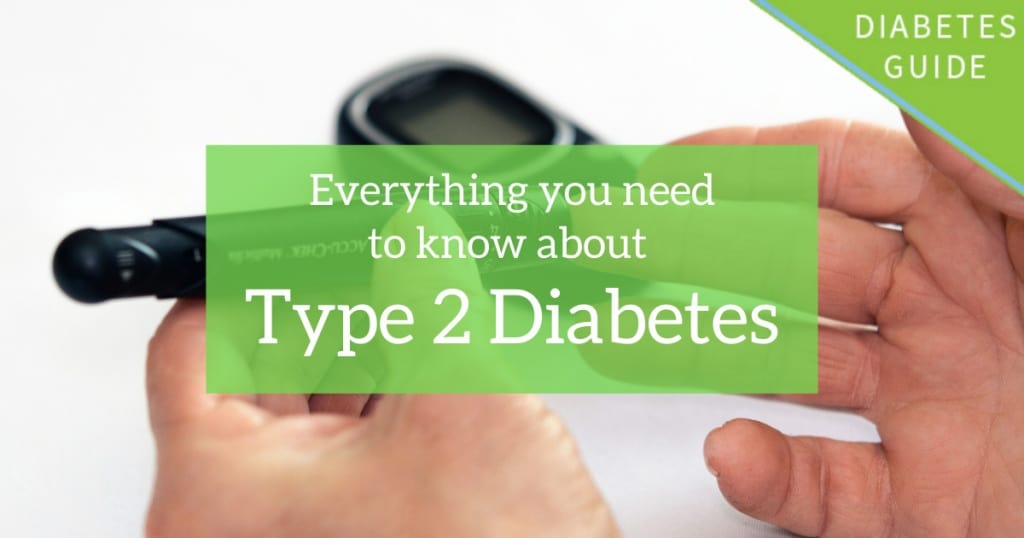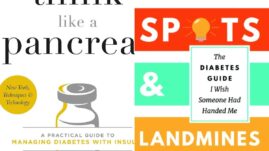There are approximately 38 million Americans living with type 2 diabetes, and another 98 million with prediabetes, most of whom are completely unaware their blood sugars are high.
The U.S. Centers for Disease Control & Prevention reports that the number of Americans with diabetes has doubled over the past 20 years, pointing to obesity as one of the biggest contributors.
Let’s take a closer look at the symptoms, diagnosis, causes, and treatment options for type 2 diabetes.

What is type 2 diabetes?
Type 2 diabetes is a metabolic disorder characterized by high blood sugar levels that are not the result of an autoimmune disease (type 1 diabetes), pregnancy (gestational diabetes), MODY (Maturity Onset Diabetes of the Young), or LADA (latent autoimmune diabetes in adults).
For people with type 2 diabetes, there is likely an issue in either their body’s ability to produce normal amounts of insulin or their body’s ability to respond properly to the insulin they do produce.
This is the difference between “insulin deficiency” and “insulin resistance.”
Causes: insulin deficiency or insulin resistance?
“It is now well recognized that 2 factors are involved: impaired [beta-cell] function and insulin resistance,” explains John E. Gerich, MD, in research published by the Mayo Clinic Proceedings.
Insulin resistance is when your body does not respond enough to normal amounts of insulin, which means your body has to produce more and more in an effort to achieve normal blood sugar levels. This can cause gradual weight gain in addition to being the result of weight gain.
Eventually, the body can’t keep up with the increasing demand for more insulin. This is when blood sugar levels start rising and a diagnosis of prediabetes or type 2 diabetes can be made.
Insulin deficiency is the result of “beta-cell dysfunction,” according to the American Diabetes Association’s journal, Diabetes Care.
Beta-cell dysfunction is when the body is struggling to produce healthy beta-cells. Beta-cells are produced in the pancreas and are responsible for secreting insulin. Without enough healthy beta-cells, a person cannot produce enough insulin to manage blood sugar levels.
This gradually worsening beta-cell dysfunction is increased blood sugar levels which leads to further weight gain, making the battle against diabetes a difficult struggle for the person living with it.
Obesity doesn’t always lead to type 2 diabetes
There is a significant portion of people who are overweight or obese who do not have elevated blood sugar levels, but the two conditions do often overlap.
“Excess weight is an established risk factor for type 2 diabetes, yet most obese individuals do not develop type 2 diabetes,” explains research from the Journal of Clinical Endocrinology and Metabolism.
Obesity and type 2 diabetes can both be much more complicated than eating too much and exercising too little.
Factors that increase your risk
The CDC lists the following as factors that increase your risk of type 2 diabetes:
- Have prediabetes
- Are overweight
- Are 45 years or older
- Have a parent, brother, or sister with type 2 diabetes
- Are physically active less than 3 times a week
- Have ever had gestational diabetes (diabetes during pregnancy) or given birth to a baby who weighed more than 9 pounds
- Are African American, Hispanic/Latino American, American Indian, or Alaska Native (some Pacific Islanders and Asian Americans are also at higher risk)
Symptoms of type 2 diabetes
The symptoms of type 2 diabetes can be very subtle and easy to ignore for years — until blood sugar levels are high enough to catch your attention.
The higher your blood sugar levels rise — or when they spike suddenly after high-carbohydrate meals — the more noticeable these symptoms will be.
- Increased thirst
- Increased hunger
- Frequent urination
- Dry mouth
- Headaches
- Feeling tired after meals
- Unexplained weight gain
- Blurry vision
If you suspect you may be struggling with some of these symptoms, contact your primary healthcare team and ask to have your blood glucose levels and your HbA1c tested.
Diagnosing type 2 diabetes
The diagnosis of type 2 diabetes results from two very simple tests:
- Testing your blood glucose level
- Testing your HbA1c
Here are the blood sugar ranges for a person without diabetes, with prediabetes, and with type 2 diabetes according to the American Diabetes Association:
| Normal | Prediabetes | Type 2 Diabetes | |
| Fasting blood sugar | 70 to 90 mg/dL | 100 to 125 mg/dL | 125 mg/dL or higher |
| 2 hours after a meal | 90 to 110 mg/dL | 140 to 200 mg/dL | 200 mg/dL or higher |
| HbA1c (%) | Less than 5.7 | 5.7 to 6.4 | 6.5 or higher |
Your doctor can perform both of these tests in the office or you can purchase test kits yourself in most pharmacies.
Long-term complications of high blood sugar levels
Ignoring type 2 diabetes can lead to the development of many complications, all of which result from long-term high blood sugar levels.
These complications are largely preventable by working with your healthcare team to improve your blood sugars and your overall health.
- Retinopathy in your eyes, which can lead to blindness
- Neuropathy in your fingers, toes, legs, feet
- Difficulty healing, which can lead to infections and amputation
- Nephropathy in your kidneys
- Gum disease and other oral health issues
- Gastroparesis in your digestive system
- Hair-loss
- Coma
- Death
High blood sugars are serious and can severely impact your health in the short-term and long-term. Talk to your healthcare team immediately if you believe your blood sugars are consistently running higher than your goal range.
Treatment options for type 2 diabetes
Whether your type 2 diabetes is the result of insulin deficiency or insulin resistance, the treatment paths are typically the same, keeping in mind that some patients with type 2 diabetes will likely need support from medications regardless of losing weight and eating a healthy diet.
Lifestyle changes
Before or in addition to taking medications, these 6 lifestyle habits can have a tremendous impact on your blood sugars.
- Improve your diet: focus on healthy non-processed food and be aware of your calorie intake.
- Exercise daily: aim for 150 minutes per week of physical activity.
- Lose weight: even losing 5 to 10 pounds makes a difference.
- Get more sleep and get treatment for sleep apnea, if you have it!
- Drink less alcohol: limit to 2 to 3 drinks a couple of times per week.
- Quit smoking: the impact of nicotine on insulin resistance is huge!
Some people can avoid using medication by making changes in their lifestyle habits, but this isn’t true for everyone.
These lifestyle changes are what anyone — including those without diabetes — are advised to adopt for optimal health. It’s important to remember that you don’t need to adopt a “perfect” diet 100 percent of the time, or engage in wildly intense exercise for it to all make a difference.
Aim for the 90/10 or 80/20 idea. 80 percent of the time, you make smart choices around food. And 20 percent of the time, you have room for less-than-perfect indulgences. The goal is to develop habits you can sustain long-term, and very few of us can sustain perfection day in and day out!
Regardless if these lifestyle habits enable you to prevent or reduce your medications, they will help your overall blood sugar management and improve your overall health!
Bariatric surgery (weight-loss surgery)
Bariatric surgery options continue to evolve and improve, and for some, this may be a worthwhile option. It’s important to remember that it’s not an easy shortcut.
Instead, weight-loss surgery requires certain qualifications for you to be a candidate, and maintaining weight loss after surgery only works if you continue to make improvements in your overall lifestyle habits around food, exercise, alcohol, and cigarettes.
That being said, more and more research is finding that the largest benefit for people of bariatric surgery for people with type 2 diabetes is the “resurfacing” of the duodenum’s mucosal lining in your small intestines.
The cells in your intestines responsible for signaling insulin production can be damaged by long-term exposure to high-sugar, high-fat diets and result in severe insulin resistance. By resurfacing the lining here, new healthy cells regrow and are able to properly signal insulin production again.
Again, it’s not a magic fix, but it offers tremendous potential for the right candidates.
Medication
Today’s pharmaceutical market is flooded with different options for treating type 2 diabetes. They all work in different ways, and depending on your body and how you react, it may take a bit of experimenting with your doctor’s help to determine the most effective medication for you.
Biguanides
This class includes the #1 most commonly prescribed diabetes drug across the globe — metformin (Glucophage). Taken orally usually twice per day, these drugs lower your blood sugars by reducing your liver’s production of glycogen which is converted into glucose and normally raises blood sugar levels.
Metformin, in particular, can also increase the amount of glucose your muscles absorb and make you more sensitive to insulin.
The most common side-effect of metformin is diarrhea. It can be significant for many patients, but there are a few steps you can take to reduce this.
The first is to always take metformin when you have food in your stomach. The second is to ask your doctor to consider prescribing the “extended-release” version which has been shown to be much gentler on the stomach.
Brands include:
- Fortamet
- Glucophage
- Glumetza
- Riomet
Sulfonylureas
One of the first drugs a doctor will likely prescribe to help you lower blood sugars, sulfonylureas help your pancreas produce more insulin.
Taken orally, sulfonylureas can lead to weight gain, hunger, and mild-to-moderate upset stomach.
Brands include:
- DiaBeta
- Glynase
- Micronase Amaryl
- Diabinese
- Glucotrol
- Tolinase
- Tolbutamide
Bile Acid Sequestrants (BASs)
This class of drugs was actually first designed to help lower cholesterol levels, but they also help lower blood sugar levels. While it’s well-understood that BASs lower cholesterol by actually removing LDL cholesterol from the body, it’s not actually clear why it’s effective in lowering blood sugar levels.
Taken orally, a unique feature is that BASs are not actually absorbed into the bloodstream which means they are safe for people with liver problems.
They can result in a little bit of gas or constipation. You may consider taking a gentle laxative along with BASs, like psyllium husk capsules.
Brands include:
- Questran
- Prevalite
- Colestid
- Welchol
Alpha-glucosidase inhibitors
This class of drugs is taken orally and lowers your blood sugar by actually preventing the breakdown and normal digestion of starches, including bread, potatoes, pasta, and corn. While it doesn’t prevent the breakdown of sugar, it can significantly slow down the rate of digestion which means it will lessen the spike in your blood sugar after eating.
These drugs should be taken after you have at least a few bites of food in your stomach to lessen the most common side-effects of gas and diarrhea.
Brands include:
- Precose
- Glucobay
- Glyset
- Volix
Dopamine-2 Agonists
Originally designed to treat high cholesterol and taken orally, these drugs have a particularly complex impact on the body’s digestion of fats and dopamine production. The result is increased sensitivity to insulin, improved glucose tolerance, and more stable post-meal blood sugar levels.
Brands include:
- Clycoset
- Parlodel
- Permax
- Dostinex
DPP-4 inhibitors
One of the newer medication options taken orally, DPP-4 inhibitors work to actually block the production of the enzyme DPP-4 in your body. This enzyme destroys a group of digestive hormones called “incretins” which are essential for blood sugar and appetite regulation after eating.
They also help your body make better use of a compound already produced in the body called GLP-1. GLP-1 stands for glucagon-like peptide-1 and it plays a major role in blood sugar regulation, appetite, and digestion.
By taking a DPP-4, your body’s own source of GLP-1 is able to stay in the body longer and lowers blood sugar levels when they’re too high.
DPP-4 has also been proven to lower cholesterol levels.
Brands include:
- Nesina
- Tradjenta
- Onglyza
- Januvia
GLP-1 receptors (or incretins)
Taken via injection, this class of drugs is generally prescribed only if a patient hasn’t seen improvements in their blood sugar with oral medication options.
GLP-1 receptors work to lower your blood sugar levels in a few ways. First, it increases your pancreas’ insulin production in response to rising blood sugar levels. It also slows down the speed of “gastric emptying” which means the glucose from the food digesting in your stomach is going to enter your bloodstream at a slower rate.
Brands Include:
- Byetta
- Bydureon
- Victoza
- Januvia
- Janumet
Meglitinides
Meglitinides are taken orally and stimulate your pancreas’ natural production of insulin.
This class of drugs can cause low blood sugars. Frequent low blood sugars should be discussed with your healthcare team in order to make adjustments in your dosage.
Brands include:
- Amaryl
- Starlix
- Prandin
SGLT2 Inhibitors
This class of drugs works by excreting excess glucose through your urine. Taken orally, they cannot be used by patients with kidney issues because the kidneys play a major role in how this drug works.
The unique side effects of this drug include frequent urination, excess thirst, and an increased risk of urinary tract infections or yeast infections. These side effects are the result of how the drug works. If your kidneys are working to excrete excess glucose, your body will need more water to help make that process possible. That will lead you to urinate more often.
That excess glucose in the urine can then lead to yeast infections because sugar feeds the growth of yeast.
Brands include:
- Invokana
- Farxiga
- Jardiance
Thiazolidinediones (TZDs)
This class of drugs, taken orally, works to lower your blood sugar levels in two ways. The first is by helping your body create new fat cells that lower your blood sugar by making better use of the insulin and glucose in your bloodstream.
TZDs also reduce the amount of glycogen (eventually converted to glucose) produced by your liver.
Rezulin is one type of TZD that was removed from the market because it was creating serious liver problems in a very small group of people. The remaining TZDs on the market have not shown signs of creating liver problems.
That being said, today’s available TZDs have proven to increase the risk of heart failure in some patients, and possibly the risk of heart attacks. Otherwise, they are known for having few side effects and are very effective at reducing A1c levels.
Brands include:
- Avandia
- ACTOS
- Rezulin (removed from the market)
Insulin
For some people with type 2 diabetes, insulin is a necessary and extremely helpful approach to improving your blood sugars. This is especially true for people with severe insulin resistance.
Insulin is one of the most powerful hormones in the human body, and taking it via injection (with a pen or syringe) comes with a great deal of education and responsibility.
Taking insulin to manage your blood sugar levels can help you prevent the many complications associated with high blood sugar levels, but it can be an overwhelming and scary thing to accept.
Work with your healthcare to make sure your insulin doses are meeting your body’s current needs, and let them know if you’re struggling to embrace this part of your diabetes treatment plan.




Adam Garnes
Informative article about Type 2 diabetes. Thank you for sharing it.
Scott Glover
You talk about how to combat early morning high sugar levels for those with type 1 diabetes. Do you have recommendations for those with type 2 diabetes?
Christel Oerum
You are right, the article we have is focused on insulin adjustments. Mayo Clinic’s main suggestion is to limit carbs at night and (in collaboration with your medical team) adjust/move any medication you might take. You can also add movement, such as a walk in the evening and/or morning. It’s also key stay hydrated
Mark
do you offer diabetes weight loss coaching?
Christel Oerum
We do not but recommend you reach out to Ben Tzeel and his team (https://www.yourdiabetesinsider.com/)
Cecilia Lopez
Hello,
I am a diabetic, type 2, and I mentor type 2 diabetics. I was wondering if I can access this site in Spanish. My mentees would really benefit from the information contained here and the recipes.
Let me know if you do, please. Thank You.
Christel Oerum
We can only provide English at this time but you should be able to use Google translate